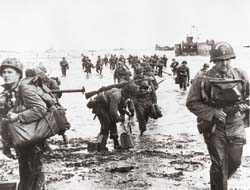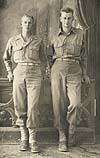 |
 |
| current issue |  |
past issues |  |
send a letter/news |  |
address update |  |
advertise |  |
about us |  |
alumni home |
Short Features
Mapping D-DayOcean-mapping experts reconstruct what happened when allied forces stormed the beaches of Normandy
by Suki Casanave '86G
June 6, 1944, 6:50 am: The skies above France's Normandy coast are thick with scudding clouds. The sea is rough. Twenty-three-year-old Fred Hall Jr. climbs from the deck of his ship and descends a rope ladder to the landing craft below.
 American soldiers land on Omaha Beach. - courtesy of Imperial War Museum |
The 16th Infantry of the U.S. Army is about to launch the beginning of the end of the war on Nazi terror. Dubbed Operation Overlord, the D-Day assault has been meticulously planned. But this morning, in an open boat on a choppy sea, the reality of war is simple and stark: a bunch of young soldiers, guns clutched to their chests, plunge through the surf and onto the beach, running straight into enemy fire. Of the 28 men in Fred Hall's boat, 14 survive.
Five beaches were stormed on D-Day, by British, Canadian and American troops. But none were more notorious than Utah and "Bloody Omaha," where the red-stained sea made it nearly impossible to tell the living from the dead. "How any of them lived through those first hours is one of the wonders of the war," wrote Don Whitehead, a journalist with Hall's division. "You just had to be lucky, and there were a number whose luck played out."
 Capt. Fred Hall '41 - by Perry Smith / UNH Photographic Services |
"Once ashore it was a matter of survival," Hall recalled in a memoir. "There wasn't much time to think except to do what had to be done." And there was the noise, the steady, awful noise of war: a barrage of fire from naval guns, small arms, artillery and mortars; roaring aircraft; the sounds of humans facing the ultimate terror--shouting, screaming, the cries of the wounded. Says Hall: "No wonder some people couldn't handle it."
August 2002: More than half a century later, Larry Mayer and Brian Calder are at work off the coast of Normandy, searching the waters for remnants of one of history's most decisive moments. "When the men were storming the beaches, they didn't have time to take notes," says Calder, a research assistant professor at UNH's Center for Coastal and Ocean Mapping (C-COM). "Basically, this survey allows us to find out what's there and try to piece together more evidence of what happened that day."
 Capt. Fred Hall '41 pictured with his friend Bob Irvine (right) in Sicily October, 1943. - courtesy of Fred Hall |
Using a multibeam sonar mounted onboard the 37-foot M/V Genesis, plus two laptop computers, the UNH researchers worked alongside colleagues from the Naval Historical Center, the Naval Surface Warfare Center and sonar manufacturer RESON Inc. to produce stunning images of the wreckage that remains on the ocean floor: sunken battleships, landing craft, tanks, Jeeps--all the paraphernalia of war. "The wrecks are considered official historic sites, war graves," says Mayer, director of C-COM and professor of earth sciences.
More than 5,000 ships, boats and other craft took part in the D-Day invasion--the largest amphibious operation of modern history, according to James Stephen Schmidt, an archaeologist with the Naval Historical Center. The number of vessels lost is impossible to pinpoint, though estimates hover around several hundred. Some of the wreckage was salvaged immediately after the war because it posed a threat to navigation. Recreational divers have also removed artifacts through the years. But much still remains to be catalogued for the historical record.
Page: 1 2 Next >Easy to print version
blog comments powered by Disqus

